Back in July of 2014, iSimangaliso Wetland Park CEO Andrew Zaloumis announced: “Within the year, iSimangaliso Wetland Park intends to realise our conservation vision of restoring all historically occurring game back into the world heritage site. With the introduction of eland, the next and final species will be brought back.”
Zaloumis says the introduction of these historically occurring species–such as wild dog and cheetah–has seen an improved balance of the eco-system and has benefited local communities in boosting tourism.
Of these, the most recent is the relocation of three male lions into the uMkhuze section of the park, which is a UNESCO World Heritage site..
The ongoing fluvial, marine and aeolian processes in the site have produced a variety of landforms, including coral reefs, long sandy beaches, coastal dunes, lake systems, swamps, and extensive reed and papyrus wetlands.
The interplay of the park’s environmental heterogeneity with major floods and coastal storms and a transitional geographic location between subtropical and tropical Africa has resulted in exceptional species diversity and ongoing speciation. The mosaic of landforms and habitat types creates breathtaking scenic vistas.
The site contains critical habitats for a range of species from Africa’s marine, wetland and savannah environments.
Photo of wild dog pack courtesy iSimangaliso Wetland Park.
See October 25, 2016 East Coast Radio article by Portia Cele.

